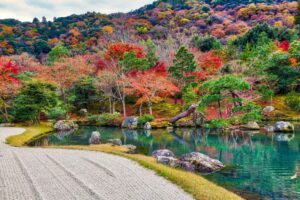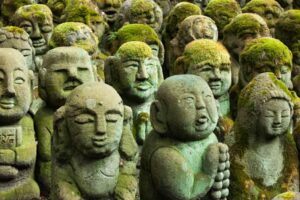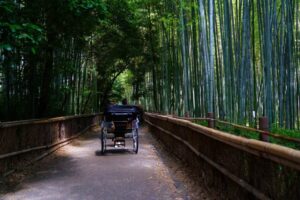Hidden in the western outskirts of Kyoto, the Arashiyama Bamboo Grove is one of Japan’s most breathtaking natural attractions. This enchanting forest is lined with thousands of towering bamboo stalks, creating a surreal, almost otherworldly atmosphere. Walking through the grove feels like stepping into a painting—one where sunlight filters through the swaying green canopy, and the gentle rustling of bamboo leaves whispers in the wind.
Beyond its visual allure, the grove holds deep cultural significance. In Japanese culture, bamboo symbolizes strength, resilience, and purity. The towering stalks have been used in traditional Japanese architecture, tea ceremonies, and even as a natural wind barrier. The forest’s unique ecosystem also makes it a vital part of Kyoto’s natural landscape, supporting various flora and fauna. With its seamless blend of natural beauty and historical importance, it’s no wonder this enchanting bamboo forest is considered a national treasure.
Arashiyama: Where Nature and History Whisper Together

Photo from arashiyama bamboo forest website
Arashiyama is more than just a picturesque destination—it’s a place where nature, history, and culture blend seamlessly. Unlike other bamboo forests, the grove in Arashiyama is carefully preserved, creating a truly immersive experience. Walking through the towering stalks feels like stepping into an ancient, living work of art, embodying Japan’s deep-rooted reverence for nature.
This area has captivated visitors for centuries. During the Heian period (794-1185), Kyoto’s aristocrats would retreat to Arashiyama for leisure, inspired by its serene beauty. The Togetsukyo Bridge, an iconic landmark, has been a subject of Japanese poetry and paintings for generations. Nearby, the UNESCO-listed Tenryu-ji Temple, a Zen Buddhist sanctuary, features one of Japan’s most stunning gardens, designed to reflect harmony between human existence and the natural world.
What makes Arashiyama truly special is its ever-changing beauty. Each season brings a new charm—spring covers the landscape in delicate cherry blossoms, summer turns the bamboo grove into a lush green haven, autumn paints the hills with fiery red and gold foliage, and winter drapes the area in a peaceful layer of snow. No two visits are the same.
Adding to its uniqueness is the Hozu River, where visitors can take traditional wooden boat rides, drifting through Kyoto’s scenic countryside. The blend of historic temples, breathtaking landscapes, and traditional experiences makes Arashiyama not just a must-visit destination, but a place that lingers in the heart long after you’ve left.
Why Everyone Should Visit Arashiyama
Whether you’re a solo traveler, part of a group, or exploring with family, Arashiyama is a perfect getaway. Couples can enjoy a romantic stroll under the towering green canopy, while families with kids will love the playful monkeys at Iwatayama Monkey Park. Locals and tourists alike flock here to escape the city’s hustle and immerse themselves in Kyoto’s tranquil side.
Arashiyama is not just about sightseeing—it offers an immersive experience. Nature lovers will appreciate the serene environment, history buffs will admire the ancient temples, and food enthusiasts can indulge in local delicacies. The blend of adventure, history, and scenic charm caters to all travelers, making it a must-visit for those seeking both relaxation and exploration. Plus, the area’s accessibility from Kyoto makes it an easy and rewarding day trip.
- Address: Sagaogurayama Tabuchiyamacho, Ukyo Ward, Kyoto, 616-8394, Japan
- Phone: 075-861-0012
- Entrance Fee: None
- Business Hours: Open 24 hours a day, 7 days a week
A Walk Through a Living Dream

Photo from arashiyamabambooforest.com
Walking through the Arashiyama Bamboo Grove is nothing short of magical. The sheer height of the bamboo creates a mesmerizing tunnel, where the world outside fades away. The gentle creaking of the stalks and the soft rustling of leaves in the breeze make for an almost meditative experience.
The bamboo grove offers a unique soundscape, classified as one of Japan’s 100 Soundscapes of Japan, a government-recognized list of places with distinctive natural sounds. The subtle swaying of the stalks in the wind creates an atmosphere of tranquility that is rarely found elsewhere.
Timing is everything. Early mornings offer a peaceful, crowd-free experience, perfect for quiet reflection. Golden hour in the late afternoon bathes the grove in warm hues, making it the best time for photography. Nighttime illuminations during special events add an ethereal glow, making the grove feel even more surreal. No matter when you visit, the ever-changing light peeking through the bamboo ensures that every trip feels unique and special.
7 Top Things to Do in and Around Arashiyama
There’s more to Arashiyama than just the bamboo forest! Here are some must-do activities that will make your visit unforgettable:
1. Walk Through the Bamboo Grove
The highlight of Arashiyama! Arrive early for the best experience and follow the path into the heart of the towering stalks. Walking slowly and taking in the shifting light and gentle rustling of the bamboo enhances the experience. The grove is also home to Tenryu-ji Temple, so you can combine both visits. The unique sound of the bamboo swaying in the wind has even been recognized as one of Japan’s “100 Soundscapes.”
2. Visit Iwatayama Monkey Park

Photo from exploreshaw.com
A short but rewarding hike up Mount Arashiyama leads to an observation deck with incredible panoramic views of Kyoto. Here, visitors can see over 120 wild Japanese macaques roaming freely. Unlike a zoo, the monkeys live in their natural habitat, and visitors can even feed them from a designated area. The hike takes about 20 minutes, and the best time to visit is in the morning when the air is cooler, and the monkeys are most active.
- Address: 61 Nakao Shita cho, Arashiyama, Nishikyo-ku, Kyoto, 616-0004 Japan
- Phone: 075-872-0950
- Entrance Fee: 800 yen for adults and 400 yen for children
- Website: monkeypark.jp
- Business Hours: open daily from 9:00 AM to 4:00 PM, except on irregular holidays and bad weather.
3. Explore Tenryu-ji Temple

Photo from arashiyamabambooforest.com
A UNESCO-listed Zen temple, Tenryu-ji is one of Kyoto’s most important and historically significant temples. Founded in 1339, the temple is known for its stunning landscape garden, which has remained nearly unchanged since the 14th century. The garden, designed by the famous priest Muso Soseki, features a large central pond reflecting the surrounding mountains. Seasonal changes bring new beauty—cherry blossoms in spring, lush greenery in summer, fiery red maple leaves in autumn, and a peaceful snow-covered scene in winter.
- Address: 68 Susukinobaba-cho, Saga-Tenryuji, Ukyo-ku, Kyoto-shi, 616-8385, Japan
- Phone: (075) 881-1235
- Website: tenryuji.com
- Entrance Fee: ¥500 for high school students and older, ¥300 for elementary and middle school students, and free for preschool children. Access to the temple buildings costs an additional ¥300.
- Business Hours: open daily from 8:30 AM to 5:00 PM, with the last admission at 4:50 PM
4. Take a Boat Ride on the Hozu River

Photo from arashiyamabambooforest.com
A peaceful escape with stunning riverside scenery, perfect for soaking in the natural beauty of Kyoto. Visitors can enjoy a traditional wooden boat ride down the Hozu River, guided by skilled boatmen who navigate through the gentle currents and rocky landscapes. This experience offers breathtaking views of the lush forests, particularly in autumn when the foliage turns vibrant shades of red and gold. For a more adventurous option, try whitewater rafting further upstream!
- Address: Shimonakajima 2, Hozu-cho, Kameoka-shi, Kyoto 621-0005, Japan,
- Phone: 0771-22-5846
- Website: hozugawakudari.jp
- Entrance Fee: ¥6,000 per adult and ¥4,500 per child (infants to elementary school students)
- Business Hours: operates daily from 10:00 AM to 2:30 PM
5. Cross the Iconic Togetsukyo Bridge

Photo from japan-experience.com
A historical wooden bridge with breathtaking views of the surrounding mountains and seasonal foliage. Originally built during the Heian period, the bridge’s name means “Moon-Crossing Bridge” because of a legend that the moon appeared to move across it at night. Today, it remains a popular photography spot, especially during cherry blossom and autumn foliage seasons. Locals often stroll here in the evening to enjoy the peaceful river breeze.
- Address: Susukinobabacho 1-5, Saga Tenryuji, Ukyo Ward, Kyoto 616-8385, Japan
- Entrance Fee: None
- Business Hours: open 24/7 and can be crossed at any time
6. Discover Hidden Paths and Temples
Arashiyama has more than just its famous spots! Some of the most beautiful temples are tucked away from the crowds, offering quiet retreats where you can experience Kyoto’s spiritual side.
Jojakko-ji Temple – A Hidden Gem with Stunning Views

Photo from theotherpaths.com
Nestled on the slopes of Mount Ogura, Jojakko-ji Temple is a quiet retreat known for its breathtaking autumn foliage and panoramic views of Kyoto. Unlike the more crowded temples, this one offers a peaceful atmosphere where visitors can truly connect with nature.
- Address: 3 Ogura-cho, Saga-Ogurayama, Ukyo-ku, Kyoto City
- Website: https://jojakko-ji.or.jp/
- Entrance Fee: 500 yen
- Business Hours: open daily from 9:00 AM to 5:00 PM (last admission at 4:30 PM)
Jojakko-ji Temple additional insights:
- The temple is famous for its vibrant maple trees, which turn brilliant shades of red and gold in the fall. In spring, cherry blossoms add to the beauty of the temple grounds.
- The thatched-roof main hall, built in the late 16th century, adds to the temple’s rustic charm.
- Climb to the top of the temple grounds to reach the pagoda, where you’ll be rewarded with one of the best panoramic views of Kyoto, stretching all the way to the city center.
- The temple is affiliated with the Nichiren Buddhist sect and is known for its emphasis on inner peace and self-reflection.
Nison-in Temple – A Path Through Ancient Cedars

Photo from arashiyamabambooforest.com
A hidden spiritual retreat, Nison-in Temple is known for its imposing cedar trees and peaceful atmosphere, making it an ideal place for quiet meditation and contemplation.
- Address: 27 Saganisonin Monzen Chojincho, Ukyo-ku, Kyoto, Kyoto Prefecture 616-8425,
- Website: https://nisonin.jp/
- Entrance Fee: ¥500 for adults, while children (up to 12 years old) can enter for free. A group discount is available at ¥450 per adult, and visitors with disabilities receive free entry.
- Business Hours: open daily from 9:00 AM to 4:30 PM.
Nison-in Temple additional insights:
- The temple was founded in the 9th century during the early Heian period and belongs to the Tendai Buddhist sect.
- The name “Nison-in” means “Two Revered Images”, referring to the two main Buddha statues enshrined here—one representing Shakyamuni (the historical Buddha) and the other Amitabha (the Buddha of Infinite Light).
- Visitors enter the temple via a long, scenic path lined with towering cedar and maple trees, creating an almost mystical ambiance. During autumn, the path transforms into a breathtaking tunnel of red and gold leaves.
- Unlike more tourist-heavy temples, Nison-in offers a quiet and spiritual escape, perfect for those looking to meditate or simply enjoy the tranquil surroundings.
Adashino Nenbutsu-ji Temple – A Hauntingly Beautiful Memorial

Photo from arashiyamabambooforest.com
For those interested in Kyoto’s deep spiritual history, Adashino Nenbutsu-ji Temple is a one-of-a-kind destination. This atmospheric temple is dedicated to honoring the souls of the nameless dead, making it a deeply moving place to visit.
- Address: 17 Sagatoriimoto Adashinocho, Ukyo-ku, Kyoto-shi, Kyoto-fu 616-8436, Japan
- Email: adashino@nenbutsuji.jp.
- Website: https://nenbutsuji.jp/eng/
- Entrance Fee: ¥500 for adults, ¥400 for junior high and high school students, and free for elementary school students and younger (with a guardian). Group rates are available for parties of 30 or more.
- Business Hours: open daily from 9:00 AM to 4:30 PM
Adashino Nenbutsuji Temple additional insights:
- The temple dates back to the 8th century, when the area was used as a burial ground for those who had no families to perform rites for them.
- Over time, monks and locals gathered the remains and placed thousands of stone Buddhist statues to memorialize the departed. Today, over 8,000 small stone figures stand in silent tribute, creating a hauntingly beautiful landscape.
- Every August, the Sento Kuyo (Thousand Lantern Memorial Ceremony) is held, where candles illuminate the stone statues, creating an ethereal, otherworldly sight.
- The temple is surrounded by bamboo groves, offering a secluded and reflective atmosphere. It’s an ideal place for quiet walks and historical exploration.
7. Meet the Rakan Statues at Otagi Nenbutsu-ji Temple

Photo from arashiyamabambooforest.com
One of Kyoto’s quirkiest and most underrated temples! This hidden gem is home to 1,200 hand-carved stone statues, each depicting a different Buddhist disciple (rakan). Unlike traditional solemn statues, these figures have expressive and sometimes humorous facial expressions, from monks laughing and smiling to those playing musical instruments. The temple, surrounded by lush greenery, offers a peaceful and off-the-beaten-path experience, perfect for those looking to explore beyond the main tourist areas.
- Address: 2-5 Fukatani-cho, Saga-Toriimoto, Ukyo-ku, Kyoto 616-8439, Japan,
- Phone: +81 75-285-1549
- Website: https://www.otagiji.com/
- Email: 1200rakan@otagiji.com
- Entrance Fee: is ¥500, while children under 15 can enter for free
- Business Hours: open daily from 9:00 AM to 4:15 PM, except on Wednesdays (unless it’s a national holiday)
Flavors of Arashiyama: What to Eat
After a day of exploring, treat yourself to local Kyoto delicacies! Here are some must-try dishes:
| Dish | Taste Description |
| Yudofu (Tofu Hot Pot) | Light, warm, and comforting, perfect for a chilly day. Found in traditional restaurants. |
| Matcha Sweets | Rich, earthy, and slightly bitter-sweet—a Kyoto specialty! Try matcha ice cream or mochi. |
| Yatsuhashi (Cinnamon Rice Crackers) | Crispy with a fragrant cinnamon taste. Available in baked and raw forms. |
| Bamboo Leaf Rice | Mild, slightly nutty, and infused with a delicate bamboo aroma. Often served in seasonal bento boxes. |
| Kyoto-Style Ramen | A lighter, soy-based broth with a deep umami flavor. Best enjoyed in local ramen shops. |
Best Time to Visit & Travel Tips
When is the best time to visit Arashiyama? The answer depends on what kind of experience you’re looking for. Whether you want to stroll through cherry blossoms, marvel at autumn’s fiery hues, or capture the ethereal glow of the bamboo in golden sunlight, each season and time of day offers something special. To make the most of your trip, here’s a guide to the best times to visit and essential travel tips.
Seasonal Highlights
- Spring: Cherry blossoms bloom, adding a pink hue to the landscape. The nearby temples become even more picturesque.
- Summer: The bamboo is at its lushest, creating a deep green paradise. Expect higher temperatures but refreshing river breezes.
- Autumn: Fiery red and golden leaves contrast beautifully with the greenery. Ideal for photographers.
- Winter: A dusting of snow turns the grove into a silent wonderland. Fewer crowds make for an intimate experience.
Best Time of Day
- Early Morning: Fewer crowds, perfect for serene walks and reflection.
- Late Afternoon: Golden sunlight filtering through the bamboo makes for stunning photography.
Getting There
- By Train: Take the JR Sagano Line from Kyoto Station to Saga-Arashiyama Station (about 15 minutes).
- Riding a Bus: Kyoto City Buses offer direct routes to Arashiyama.
- Biking: Rent a bike for a scenic ride through the countryside.
Photography Tips
- Use a wide-angle lens to capture the towering height of the bamboo.
- Shoot vertically to emphasize the depth of the grove.
- Capture the light and shadows during golden hour for a dreamy effect.
Why Arashiyama is a Bucket List Destination
Arashiyama is more than just a bamboo forest—it’s a place where nature, culture, and adventure come together in perfect harmony. Its rare beauty is something you won’t find just anywhere. Each season transforms the landscape, making every visit a fresh experience. Whether you’re looking for a tranquil retreat or an exciting day of exploration, Arashiyama offers the best of Kyoto in one unforgettable setting.
A Final Note: Don’t Miss This Magical Experience

Photo from arashiyamabambooforest.com
Arashiyama Bamboo Grove is a place that stays with you long after you’ve left. The towering bamboo, historic bridges, and serene temples create a perfect blend of nature and culture. Each season offers something new, from cherry blossoms in spring to fiery autumn leaves and tranquil winter landscapes. Whether you’re seeking peace, adventure, or breathtaking views, Arashiyama delivers.
When in Kyoto, don’t just pass through—take the time to truly explore. Walk beneath the swaying bamboo, enjoy a riverside boat ride, and savor Kyoto’s local flavors. Let Arashiyama’s beauty leave an imprint on your journey, creating memories you’ll cherish long after you’ve left.
Frequently Asked Questions
Is there an entrance fee to visit Arashiyama Bamboo Grove?
No, the bamboo grove is free to enter and open 24/7. However, nearby attractions like Tenryu-ji Temple require an admission fee.
Is Arashiyama Bamboo Grove accessible for people with mobility issues?
Yes, the main bamboo path is relatively flat and well-maintained, making it accessible for wheelchairs and strollers. However, some surrounding attractions may have steps or uneven paths.
How much time should I spend in Arashiyama?
A half-day is enough to explore the bamboo grove, Tenryu-ji Temple, and Togetsukyo Bridge. A full day allows time for activities like boat rides, visiting Iwatayama Monkey Park, and trying local cuisine.
Can I take professional photos or videos in the bamboo grove?
Yes, photography is allowed, and the grove is a favorite spot for photographers. However, tripods and drones are generally discouraged due to space constraints and local regulations.
Are there restaurants and cafes nearby?
Yes! Arashiyama has plenty of local eateries offering Kyoto specialties like matcha sweets, tofu dishes, and Yatsuhashi (cinnamon rice crackers). There are also scenic riverside restaurants.

